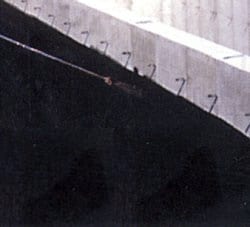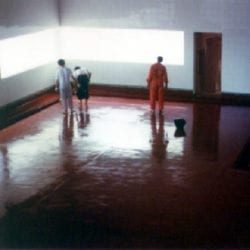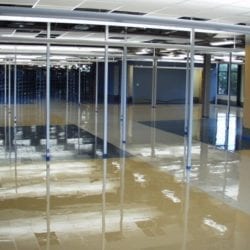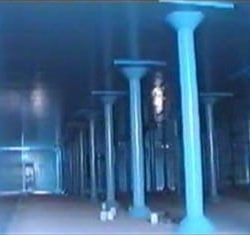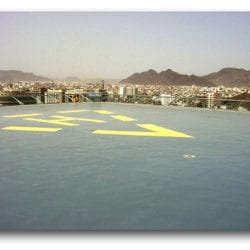USES
CHEM-TAR LC provides protection to concrete and metal structures against corrosion from chemical environment. Areas of application:
- Sewage and water treatment plants.
- Sewage tanks and fire water tanks.
- Effluent treatment plants.
- Harbor and dock installations.
- Manholes and sewer lines.
- Power plants, refineries and sub-stations.
- Nuclear plants and thermal power stations.
- Irrigation water pipes.
TECHNICAL
Technical Data for Unmixed Parts
| Property @ 25°C (77°F) |
Resin – Part A |
Hardener – Part B |
Test Method |
| Solids |
100 % |
100 % |
– |
| Color |
Black |
Clear |
–
|
| Density, Lb/Gal (Kg/L) |
13.65 (1.64) |
7.7 (0.93) |
ASTM D-1475 |
| Mixing Ratio A: B |
≈ 5: 1 By Volume |
– |
| Shelf Life |
2 years |
2 years |
–
|
Technical Data for Mixed Parts
| Property (Mixed A & B) |
Value @ 25°C (77°C) |
Test Method |
| Mixed Density, Lb/Gal (Kg/L) |
12.77 (1.53) |
ASTM D-1475 |
| Mixed Color |
Black |
–
|
| Solids, % |
93 |
|
| Gel Time @ 60 grams, minute |
240 |
ASTM D-2471 |
| Pot Life @ 1 Gal (3.785 Liter), minute |
20 |
–
|
| Shore Hardness @ 7 Days, A |
56 |
ASTM D-2240 |
| Bond Strength @ 7 Days, Psi (MPa) |
184 (1.27) |
ASTM C-4541 |
| Elongation, % |
> 60 |
ASTM D-522, Method A |
| Water Absorption 24 hrs, % |
0.068 |
ASTM D-570 |
| Touch Dry @ 200 microns, Hour |
5 |
–
|
| Maximum Recoat Interval, Hour |
24 |
–
|
| Final Cure, day |
7 |
–
|
APPLICATION
Limitations: Do not apply on surfaces, which have been sealed with permanent type form oil, curing compounds or release agents. Application at ambient temperatures below 41°F (5°C) is not recommended. Exposure to temperatures exceeding 151°F (66°C) for prolonged periods is not recommended.
Surface Preparation: Surface of application should be clean and sound. The Concrete or cementitious substrates should be at least 28 days old and moisture content of substrate should be less than 5%. Concrete to receive high performance overlay systems should be designed, mixed and placed in accordance with internationally accepted practice. Sufficient compressive and tensile strengths to withstand dynamic loading is required. Good and dense surface is essential, too dense surface caused by over trowelling or finishing with steel floats can lead to adhesion failure.
All laitance and loose materials must be removed from the concrete surfaces. If the concrete is strong, crack-free and sound with light laitance, surface preparation may be achieved by acid etching followed by thorough water washing using high pressure water jetting ensuring all traces of acids are removed.
Areas of deeply penetrating contaminations by oil, greases and fats should be flame cleaned by hot compressed air or thoroughly washed by good industrial detergent. The cleanly washed substrate is then allowed to dry completely.
Cracked or damaged concrete or heavy laitance should be removed and prepared by grit blasting, scrabbling or mechanical grinding until a solid surface is reached showing exposed aggregate.
Any corroded reinforcement should be exposed at least 10 mm around the reinforcement and shot blasted to Swedish standard SA 2 ½ (bright metal). Avoid featheredges in the concrete. Repair areas by saw cutting to a minimum depth of 5 mm. Remove all damaged concrete until achieving a solid base. Blow out all the dust from the area of repair. Steel tanks and surfaces should be free from rust scales, grease, oils and any other impurities, which impair strong adhesion with CHEM-TAR LC. Corroded steel should be sand blasted to Swedish Standard SA 2 ½. Coating process should proceed within two hours from sand blasting.
Concrete Repair: Major concrete repairs might require the application of a new layer of concrete or repair by either cementitious repair mortar or grout. Concrete cracks should be repaired by injection or routing the crack into a ‘V’ shape them filled with proper epoxy putty. Concrete pinholes should be filled using the proper epoxy pinhole filler. Un-even concrete surfaces and cavities should be leveled to produce a smooth flat surface using an appropriate epoxy repair mortar technique. Expansion, control and isolation joints in concrete substrates should be maintained out through applied system and filled with an appropriate sealant.
Mixing Procedure: Prior to the application, CHEM-TAR LC should be stored at 77°F (25°C) maximum temperature for a minimum of 24 hours to allow consistent workability and better finishing qualities. Pour the entire content of part B into the container of part A. Mix the epoxy with a slow speed drill with a mixing paddle. Scrape the sides and bottom of the pail during mixing. Blend for 3-5 minutes. Mix only the amount of material that can be used within the pot life.
Please Note: Large batches of epoxy will cure much faster than small batches. Mixed epoxy will cure much faster in hot weather than in cold weather. If necessary, adjust the viscosity by adding up to 5% solvent.
Application: The coating shall be applied onto the pre-treated substrate using a good quality paintbrush, roller or airless spray equipment. Apply first coat of CHEM-TAR LC at an average coverage of 300 grams per 1 m2 at 200-micron dry film thickness. Allow the first coat to reach its initial curing. Within the recoat interval period, i.e.: 18-24 hours the second coat should be applied. Should there be any delay in application of second coat and the recoat interval period is exceeded the first coat should be roughened before the application of the second coat. Apply the second coat of CHEM-TAR LC at an average coverage of 300 grams per 1 m2 at 200-micron dry film thickness. Depending on the specification, additional coats can be applied to the required thickness.
Curing: Protect the freshly applied coating from rain, dew, dust and traffic for a minimum of 24 hours. The coating should not be exposed to aggressive chemicals and liquids for the 7 days full cure.
Cleaning: remove uncured CHEM-TAR LC from tools and equipment with suitable solvents such as Xylene, Toluene or CHEM-CRETE BLENDED SOLVENT immediately after use. Cured material may only be removed mechanically.
STORAGE
The product can be stored for minimum of twelve months at temperature from 41°F to 77°F (5°C to 25°C) in the unopened original packaging. Protect from. Store undercover and protect from direct sunlight and extremes of temperatures.
SAFETY
After full curing, CHEM-TAR LC is physiologically harmless. As with all chemical products, care should be taken during the use and storage to avoid contact with eyes, mouth, skin and foodstuffs. Treat splashes to eyes and skin immediately. If accidentally ingested, seek immediate medical attention. The uncured mixture can cause irritation of the skin. The best protection is to wear protective gloves mask and goggles while working. The use of solvents should be avoided. The empty containers may contain residues of the product and should not be used for any purpose, and should be disposed off in accordance with local regulations.
WARRANTY
LIMITED WARRANTY: International Chem-Crete Inc. warrants that, at the time and place we make shipment, our materials will be of good quality and will conform to our published specifications in force on the date of acceptance of the order.
DISCLAIMER: The information contained herein is included for illustrative purposes only and to the best of our knowledge, is accurate and reliable. International Chem-Crete Inc. is not under any circumstances liable to connection with the use of information. As International Chem-Crete Inc. has no control over the use to which others may put its products, it is recommended that the products be tested to determine the suitability for specific applications and/or our information is valid in particular circumstances. Responsibility remains with the architect or engineer, contractor and owner of the design, application and proper installation of each product. Specifier and user shall determine the suitability of the product for specific application and assume all responsibility in connection therewith. AM270311

